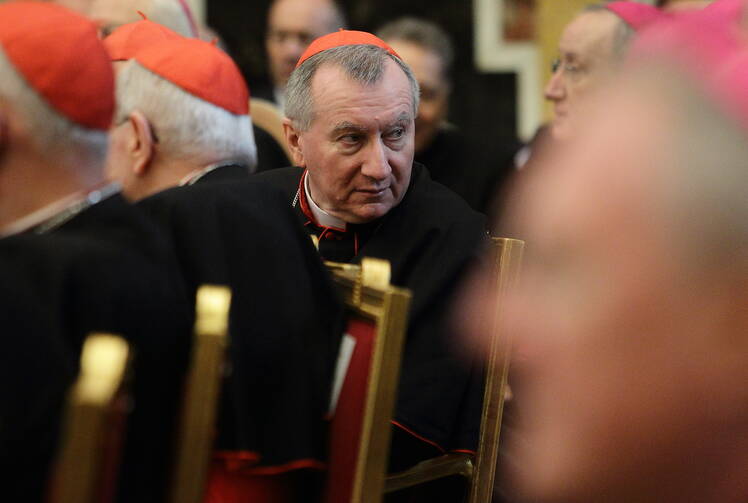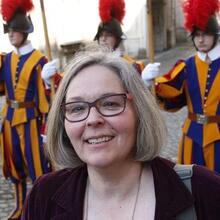VATICAN CITY (CNS) -- Pope Francis' plan for the reform of the Roman Curia will change the names of several offices and merge a few of them, but the biggest change it hopes to spark is one of attitude.
The last major reorganization of the Curia came with St. John Paul II's apostolic constitution, "Pastor Bonus" (The Good Shepherd) in 1988, which -- in its very first sentence -- spoke of Jesus entrusting the apostles with "the mission of making disciples in all nations and of preaching the Gospel to every creature."
To facilitate that mission in the modern world, St. John Paul had said, the church needs a structure to promote "communion," which "glues the whole church together."
Pope Francis' successor document to "Pastor Bonus" is tentatively called "Praedicate Evangelium" (Preach the Gospel), and drafts of it were sent to bishops and a variety of experts for comment in the spring.
Of course, promoting the communion of the church and preaching the Gospel are essential tasks for the popes. For Catholics they are inextricably bound together, and one makes little sense without the other.
But when one is emphasized more than the other, priorities change.
In 2013, cardinals said one thing they wanted under a new pope was a reform of the Roman Curia to promote efficiency and a greater sense of service to bishops around the world.
The energy of the Curia can be directed to promoting unity, offering direction and gathering suggestions and ideas, a somewhat inward gaze that could increase the perceived authority of curial officials. The risk is a tendency toward uniformity and thinking that the closer one is to the center, the more authority he has.
On the other hand, the Curia's efforts can focus on encouraging outreach and new initiatives for evangelization, an outward gaze that could decrease the perceived authority of curial officials. The risk here is possible fragmentation and a sense that every diocese, movement and group is free to do its own thing.
Finding the right balance has been a goal of Pope Francis and his international Council of Cardinals.
At the pre-conclave meetings before the election of Pope Francis in 2013, cardinals said one thing they wanted under a new pope was a reform of the Roman Curia to promote efficiency and a greater sense of service to bishops around the world.
Bishops from every continent who have made their "ad limina" visits to the Vatican over the past six years have said that already is occurring. Previously, many have said, they would visit a Vatican office and be told what they needed to do; sometimes it even approached a scolding. Now, they say, the predominant attitude is: "How can we help you?"
The structural reorganization of the Roman Curia has taken much more time than many people expected. Six years ago the pope and members of the Council of Cardinals began studying each Vatican office, its responsibilities, special projects and staffing. Only then did they begin discussing ways to reform the Curia.
Bishop Marcello Semeraro of Albano, council secretary, told reporters in late June that the council hoped the new constitution could be finalized and given to the pope in September, but certainly by the end of the year.
"Praedicate Evangelium" says the reform of the Curia should involve "lay women and men in governing roles of importance and responsibility."
News reports about leaked copies of the draft obviously focused on the "news": the combining of the Congregation for the Evangelization of Peoples and the Pontifical Council for Promoting New Evangelization into the Dicastery for Evangelization; the fact that the Dicastery for the Doctrine of the Faith is listed after the evangelization office, which some read as downgrading its importance; and combining the Congregation for Catholic Education and the Pontifical Council for Culture.
But like with "Pastor Bonus," the names of offices of the Roman Curia and their tasks as outlined in "Praedicate Evangelium" make little sense apart from the introduction explaining the role of the Curia.
The introductions of the two documents both use the word "diakonia" -- service -- and both speak of the curial offices as an extension of the ministry of the pope in whose name the Curia acts.
Most commentary on the new draft document has tended to focus on how the Curia will be losing power, especially in relation to local bishops and bishops' conferences. However, some seem to think the emphasis on the Curia being at the service of the pope means the pope gains power under the new arrangement.
The draft document gives a high-profile coordinating role to the Vatican Secretariat of State, but it is a role that it has had for the past 30 years.
Pope Francis is not about to dismantle the hierarchical structure of the church -- a structure he believes is a gift of God -- but he does see plenty of room for expanding the voices heard in any discussion.
"Pastor Bonus" said, "The Secretariat of State provides close assistance to the supreme pontiff in the exercise of his supreme office." The English translation of "Praedicate Evangelium" uses almost the exact description: "The Secretariat of State closely assists the supreme pontiff in the exercise of his supreme mission."
And both documents specify that the secretary of state is a cardinal.
Unlike "Pastor Bonus," which said that prefects of congregations must be cardinals, in Pope Francis' document the Secretariat of State is the only office where a cardinal head is explicitly required.
"Pastor Bonus" also stated that the full members of most of the congregations were cardinals and "some bishops," while the consultants could include priests and lay experts.
Pope Francis seemed to signal a change already in early July when he named seven women and a religious brother as full members of the Congregation for Institutes of Consecrated Life and Societies of Apostolic Life.
"Praedicate Evangelium" says the reform of the Curia should involve "lay women and men in governing roles of importance and responsibility."
Reflecting a frequent call of Pope Francis, the draft document includes references to "synodality" and creating a more "synodal church," meaning one in which all members listen to one another, reflect together and offer each other their talents.
Pope Francis is not about to dismantle the hierarchical structure of the church -- a structure he believes is a gift of God -- but he does see plenty of room for expanding the voices heard in any discussion.
A new curial structure is not the goal, the draft says. Rather, the aim is to promote a stronger Christian witness, more effective evangelization, more fruitful ecumenical engagement and "a more constructive dialogue with all."










